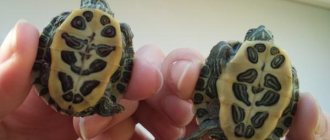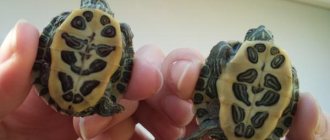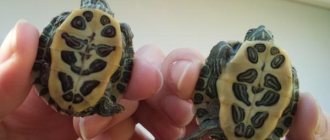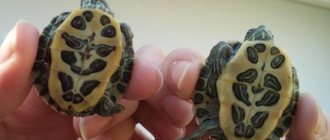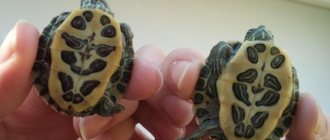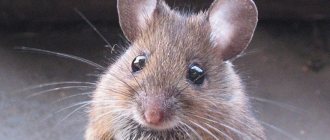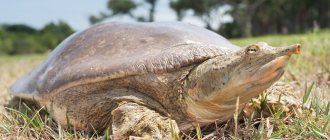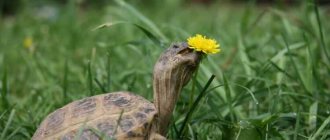To ensure that the purchased exotic reptiles grow healthy and develop well, you should find out what to feed the red-eared slider and how to diversify the diet before purchasing it. It is better to stock up in advance on those products, plants and dry food that are needed.
What do turtles eat in the wild?
The main component of the diet of red-eared turtles in the wild are shellfish: mussels and snails, oysters, and crustaceans. They have no teeth, but this does not prevent them from excellently dealing with mollusk shells: with strong jaws they break them and eat the pulp.
In the summer, insects become food for turtles: grasshoppers, beetles, etc.
They are very fond of algae, plankton and small fish. They also eat tadpoles, fish fry and frogs.
Suitable varieties
The main food for red-eared turtles is fresh, low-fat fish, mainly small river fish. Factory-made food, as well as meat and bloodworms, cannot provide the correct ratio of elements for the development of a pet and should be given only in addition to the main diet. But not all fish will be useful for the red-eared turtle; it is recommended to choose the following varieties:
Regular consumption of fish will protect your pet from rickets and vitamin imbalance; small turtles (up to 2 years old) need to be fed this way daily. Many manufacturers offer turtle food based on dried fish. This option is suitable for supplementary feeding or in case of departure of the owners, but cannot provide the correct diet. Also, if you constantly buy granulated food, the turtle may become weaned from fresh food and refuse to eat.
Diet of the red-eared slider
A necessary aspect of caring for turtles is preparing the right diet. The health of your pet depends on feeding high-quality, fresh and, importantly, varied food. How the red-eared turtle feeds, how long it lives, and how it feels are closely interconnected.
In captivity, this reptile has little demand for food. For a tough shell and healthy skin, reptiles require both plant and animal products. For turtles up to one year old, the latter must be included in the diet in an amount of 80% or more.
A reptile's hard shell requires plant and animal products.
Mature turtles need to increase the amount of plant foods rich in fiber and vitamins. As a result of eating only meat, pets can develop rickets, hypovitaminosis or obesity.
The required vitamins and dietary supplements must be regularly added to food.
Recommendations for how many times per day to feed your red-eared slider will depend on the age and preferences of the individual reptile.
If the turtle is up to 1-1.5 years old, there should be one or two meals a day. If you have no appetite, reduce the amount of food or go on a short hunger strike for 1-2 days.
To create an optimal nutritional regimen for an adult, you should observe the pet and feed it on demand. If a turtle is hungry, it becomes overly active in the presence of its owner, hitting the water with its paws. After feeding, she calms down and rests calmly. A turtle may require food daily, or maybe once every 7 days.
Description of the marsh turtle
If we were painting a portrait of a marsh turtle, then its most important detail would look like this: an almost oval, small-height carapace (about the term - help below), in which the width of the rear part is clearly greater than the front. In the largest individuals, the length of the carapace reaches 20 centimeters or more.
The carapace is the convex dorsal shield of a turtle's shell, consisting of a bone base and a horny covering.
Due to the fact that these turtles mainly live in the water element, the carapace of the animal is tightly pressed to each other, and it itself is streamlined in shape, without any protrusions, the fingers are connected by membranes. The turtle's paws have large and sharp claws, which is logical, since it is a predator. With their help, the turtle is able to tear its prey apart (your hand will not be the object of the hunt, but you should not let your guard down when communicating with your pet).
The tail of this reptile is quite long (up to 12 cm, which is often ¾ of the entire length of the shell). Its main function in the water is to guide and assist in maneuvering, creating a counterweight and maintaining balance during sharp turns. Moreover, in females it is shorter than in males.
The average weight of a reptile is 1.5 kg.
As for the color scheme, the swamp pet’s carapace is usually dark (from olive and khaki to almost black), but the plastron is light (closer to yellow). The body is densely covered with small light splashes and spots. The eyes depend on the gender: in males they are most often red, and in females they are light shades.
Habitat
The known European marsh turtles can be seen in large numbers in Europe, Asia or Africa. Their habitats are bodies of water (from swamps to streams, rivers and ordinary puddles somewhere in the forest). Water is an absolute comfort for them, but they also love to bask in the sun, and to do this they have to crawl onto the shore or rocks protruding upward. These creatures try to catch the sun's rays even on the coolest and gloomiest days. But as soon as the turtle hears an extraneous sound, it will immediately run into shelter (water) from the unpleasant attention. Strong paws allow the swamp beauty to swim quickly, and its claws allow it to instantly bury itself in the mud or under foliage near the shore.
With the arrival of cold weather, in mid-autumn, picky animals hibernate: this is how they escape the winter cold. With the warmth of spring, they wake up again.
Basic feeding rules
To properly feed a red-eared turtle, you must comply with the basic conditions and some subtleties:
- Any food needs to be cut into pieces: the smaller the turtle, the smaller the pieces.
Any food needs to be cut into pieces
- Aquatic reptiles tear large pieces with their sharp claws, so that plant food can be fed whole.
- Before serving, products must be washed, seeds and peels removed.
- The pet should eat the food within 30 minutes. The serving size should be calculated based on this indicator, and should not exceed half the size of the shell. You can also give pieces of food the size of the reptile's head.
- Feed should be given at room temperature. Very cold food is harmful to your pet's health.
- Turtles search for food using their vision. The more attractive the color of the food, the faster she will find and eat it. For this you can use carrots and tomatoes.
- It is better to feed your pet in the morning, but it is not essential. It is important that she has time to digest what she eats during daylight hours or with the lamp on.
- Uneaten food must be immediately removed from the reservoir - this way the reptile will develop the habit of eating at certain hours.
There are different ways to feed armored animals: with tweezers, from a special bowl, or by throwing them into water.
You can feed red-eared turtles with tweezers
It is best to feed the red ear in another aquarium or basin, because leftover food will contaminate the terrarium, and the water will have to be replaced frequently.
You can also teach him to eat on an island equipped in the aquarium. First, food is placed at the very edge of the shore near the water. If the reptile is hungry, it will have to take food. So gradually get used to eating from a small saucer with water.
You should not hand feed your reptile too often to avoid getting used to this method of feeding and refusing to eat differently. There is also a risk of being bitten.
You cannot distract your pet while eating: sudden movements and loud sounds frighten him.
How to handle a pet
Like all turtles, the swamp species is quite smart
The pet quickly gets used to the person, but you still need to be careful when communicating, they are insidious, and if they are in a bad mood they can bite, and it can even hurt! The turtle understands perfectly well that the person has come to feed it, and will quickly rush to land to receive the coveted portion. When feeding, such individuals are aggressive, and it is better to give pieces carefully, without exposing your hands too much.
When feeding, such individuals are aggressive, and it is better to give pieces carefully, without exposing your hands too much.
The turtle understands perfectly well that the person has come to feed it, and will quickly rush to land to receive the coveted portion. When feeding, such individuals are aggressive, and it is better to give pieces carefully, without exposing your hands too much.
You must handle your pet very carefully, and it is better not to touch him at all when the turtle is not in a good mood. She will show her aggressive attitude by snorting and hissing. If you ignore the warning, the turtle will make sudden jumps
If you ignore the warning, the turtle will make sudden jumps.
such a pet is not a toy for children; they pose a mutual danger to each other. Immediately warn your child that such a pet cannot be played with, picked up, and can only be stroked under the supervision of an adult.
Swamp turtles are very aggressive towards each other, they fight and gnaw off their tails, so only one turtle is allowed to be kept. Other species are food for them, do not add a turtle to fish, and vice versa.
What can you feed your red-eared slider?
At home, you can use special food purchased at a pet store to feed your red-eared reptile. If your pet shows signs of illness, for example, a red-eared slider's shell is peeling off, you should pay attention to the quality of its diet.
For the main diet, meat and offal, cottage cheese and eggs are used, as well as fish, seafood and insects. The use of various types of plants, vitamin and mineral supplements is recommended.
Animal feed
This food serves as the basis for the diet of aquatic turtles. For a growing animal, the portion size and variety of food should be increased.
Red-eared turtles prefer live food: snails, small fish, insects and crustaceans. Such nutritional components will be good for diversifying your diet, but you shouldn’t get too carried away with them. It is enough to apply them 2 times a month.
Red-eared turtles prefer live food, but you shouldn’t get carried away with it
Food can be served either raw or cooked, unsalted and unseasoned, divided into pieces.
Meat
The red-eared slider's diet may include lean beef, horse meat, rabbit, chicken and turkey.
Reptiles also eat minced meat. Finely chopped plant food is added there if the turtle refuses it.
By-products
By-products should be added systematically to the red ear's diet. From a wide variety, you should choose only beef or poultry liver and heart. They contain a significant amount of vitamin A, which helps normalize the growth of the pet and maintain healthy skin. Due to a deficiency of this vitamin, detachment of the horny scutes, development of conjunctivitis, etc. are possible.
By-products should be added to the diet systematically
It is recommended to give liver only to adult turtles once every 30 days.
Cottage cheese and eggs
It is difficult to feed cottage cheese to replenish calcium levels to a turtle - it disintegrates in water. But they like to catch it and eat it.
Eggs are used raw, mixed with various types of products.
Fish and seafood
Fish is recommended in raw low-fat varieties (up to 3.0%), such as hake, blue whiting, pollock and cod, and freshwater perch. River species are best suited.
Before feeding, you can remove large bones from the fish, but leave the giblets, because the turtle needs all the useful substances contained in the fish to maintain the rigidity of the shell and skeleton as a whole.
In order to eliminate the negative effects of thiaminase in raw fish, immediately before feeding, it is necessary to put it in hot water for 2 minutes.
Among marine products, green shrimp are used as food for reptiles; they enjoy octopus and squid, and eat mussels and snails.
Reptiles enjoy eating octopus, squid, and shrimp.
If there are fish or frogs living with the turtle, there is a high chance that it will eat them.
Insects
The menu of the red-eared turtle should include insects: beetles and hairless caterpillars. He loves to eat grasshoppers and crickets, earthworms, and also eats mealy bug larvae.
In summer they are collected in the garden and park. But you can’t collect it where it has been treated with chemicals.
Cockroaches caught at home should absolutely not be given in order to avoid insecticide poisoning.
Pet stores sell bloodworms and mealworms to feed armored reptiles.
It is recommended to purchase gammarus - small dried crustaceans. It contains a significant amount of calcium. Koretra and daphnia are also suitable food for your pet.
Insects are used as food for the turtle 1-2 times a week.
Fruits
All types of fruits contain many vitamins.
To the question whether a red-eared turtle can have an apple, there is one answer - you can also have a pear, a banana, an orange and a peach, or a plum and an apricot. Only citrus fruits should be peeled.
You can give your red-eared turtle apple, pear, banana and other fruits.
It is also recommended to occasionally give strawberries, wild strawberries, and pamper your pet with raspberries and other berries. The turtle can also have melon and watermelon.
Vegetables
Vegetables are rich in fiber, which is very beneficial for the gastrointestinal tract, and in particular, the process of food absorption, as well as vitamins A and K, calcium.
These reptiles eat cucumbers, zucchini, cabbage leaves, and red tomatoes, bright sweet peppers, pumpkins, carrots and beets attract their attention. You can even offer beans and asparagus.
They are given raw, without signs of spoilage and without mold. Cooked vegetables have no benefit for the turtle.
Mushrooms
Along with vegetable and fruit food, the red ear can be fed once every 7 days with mushrooms: slices of russula, champignons and boletus.
Greens and plants
These products are also important in the diet of turtles. They must consume them at least 50% of the total diet, and for older turtles this figure reaches 75%.
It is also recommended to feed these reptiles indoor plants, for example, thornless cacti and agave, tradescantia, hyacinth and hibiscus. It is very useful to feed with herbs from meadows, dandelion, coltsfoot, as well as plantain and clover. These reptiles have a good appetite for carrot and beet tops, lettuce leaves, basil and parsley, and dry hay. It is recommended to feed with sprouted wheat or oats (cut sprouts 5-10 cm).
These reptiles have a good appetite for carrot and beet tops
The greens are picked in the garden or in the forest far from roads, sorted and washed.
Aquatic plants, for example, duckweed, hornwort, pistia, water hyacinth, etc. are extremely useful for these reptiles.
It is better to breed them separately. After all, the algae growing in an aquarium with red ear is constantly plucked by it, which disrupts the landscape design. Having eaten algae, she may not accept other food.
Duckweed can be caught from a nearby pond.
Toxic algae (elodea and limnophila) are destructive to turtles.
What do herbivores like?
Most of the food for herbivorous turtles should be fresh greens; it is better to give the animals salads, leaves, and herbs. 1/5 of the diet may include vegetables: carrots, zucchini, pumpkin, unsweetened fruits are acceptable in moderation. A small slice of apple or pear once a week will please your pet and will not cause harm to its health.
It is imperative to dilute the diet with specialized food for turtles, bran, soybean meal, and dry yeast. However, the following foods should not be given to vegetarians:
- meat in any form, including minced meat;
- fish;
- food for cats or dogs;
- bread.
A competent approach to nutrition will allow the animal to remain healthy and active for many years, delighting the owner with its funny antics.
Artificial feed
Pet stores have a wide variety of balanced foods specifically for armored reptiles. They can come in various forms: capsules, tablets, granules and even flakes. And their compositions will vary. But for the most part, the food produced by the manufacturer often does not satisfy all the needs of the reptile’s body.
In essence, turtle food is food for aquarium fish that has been improved to meet the needs of the reptile's body. Due to the specific smell, pets may even ignore it, but over time they get used to it.
This type of feeding is convenient, but you cannot feed it alone
This type of feeding is convenient primarily for busy people, but it is not the only way to feed. Such feeds often do not maintain the balance recommended by veterinarians, which can lead to vitamin deficiency and digestive problems for the animal.
Mineral mixtures and vitamins
It is necessary to feed the aquatic turtle with vitamin and mineral mixtures. Active growth, healthy skin, and proper development of the skeleton and bone tissue depend on them.
Aquatic turtles receive useful substances not only from a variety of foods, but also from special supplements. The diet of such a pet should contain moderate amounts of vitamins A, B12, D3, E, as well as minerals such as selenium and calcium.
Regular feeding with calcium-containing preparations is especially important for turtles to strengthen their shells, especially in growing young individuals. With calcium deficiency, it can become crooked and lumpy. Claws may also become bent, limbs may occasionally break, and in extreme cases, the shell may even fall apart or become like cardboard. In nature, sources of calcium for turtles are limestone, oyster shells, corals, dolomites, and animal bones.
Calcium-rich foods include the popular gammarus. A significant amount of it is found in bone meal, ground egg shells, and also in feed chalk. They are given 100 mg of the mixture per 1 kg of pet’s weight once every 7 days.
The most applicable drugs are purchased at a veterinary pharmacy or pet store.
Feed containing vitamins and minerals (except calcium) cannot be stored for a long time. Vitamins for the prevention of vitamin deficiency C and E and mineral supplements are given only once a month, mixed into the food.
Vitamins and mineral supplements are given only once a month, mixed into the food
To ensure that the turtle consumes all the added nutrients, you should mix them with food and feed them by hand.
Ready-made food in a pet store
Dry food for red-eared turtles can be used only in cases where it is not possible to maintain a balanced diet using natural products.
Although manufacturers promise to fully satisfy the reptile’s needs for the necessary substances, they do not recommend making semi-finished products a monotypic type of food in order to avoid metabolic disorders and problems in the gastrointestinal tract.
Food for cats and dogs
It is not recommended to use either dry or wet dog or cat food for feeding red-eared turtles.
This combination food is specially developed in the optimal ratio for feeding warm-blooded animals, so it is not suitable for reptiles. It contains a set of substances that are absolutely useless for turtles.
Vitamin and mineral supplements for these pets also do not meet the needs of the turtle’s body.
Homemade food for red-eared turtles
It is possible to prepare food for pets with shells yourself at home.
For this you will need:
- cabbage – 50 g;
- squid meat – 100 g;
- lean fish – 145 g;
- carrots – 70 g;
- apples – 50 g.
Grind all the components using a meat grinder, break 2 eggs into it. Dilute 30 g of gelatin in 150 ml of hot water. Mix all ingredients thoroughly with 150 ml. milk.
Grind all components of the feed using a meat grinder
Keep in the refrigerator for 7 days only. Feed in small pieces. This food is enough for 10 meals for one turtle with a shell length of 15 cm.
If you replace gelatin with agar-agar, the food will dissolve more slowly in water.
Here's another recipe for making your own food.
Take the following products:
- squid – 0.3 kg;
- pollock – 1 kg;
- shrimp – 0.5 kg;
- gelatin or agar-agar – 150 g;
- hake – 1 kg;
- water – 750 ml.
Prepare the mixture as follows:
- Grind fish and seafood in a meat grinder.
- Dissolve agar-agar in water and let it swell.
- Mix the resulting minced meat well and heat over low heat for 10 minutes.
- Add dissolved agar-agar, mix thoroughly for 15 minutes.
- Pour the prepared mixture onto a baking sheet or into a plastic container and let it cool completely.
- Place on the refrigerator shelf for 5 hours.
- Cut the resulting mass into small pieces, wrap each in a piece of foil.
- Place them in the freezer.
For feeding, a portion of frozen food is taken out 4 hours in advance and thawed at room temperature.
The food is taken out 4 hours in advance and thawed at room temperature.
This supply will be enough for a red-eared pet with a shell size of 20 cm for a whole year.
Arrangement of the aquarium
The owner should worry about the turtle’s comfortable life at home in advance. This applies primarily to the arrangement of the home of an exotic beauty. To make a comfortable house for her, you need to purchase:
- Aquarium with a capacity of 150-200 liters.
- External or internal filter for water purification.
- Heating lamp.
- Ultraviolet lamp for aquatic turtles with UVB 10%.
- 100 W heater.
- Materials for arranging coastal or island space. Pet stores offer a completely finished island.
- Lamp and thermometer.
Often future owners prefer not to bother themselves with following all the recommendations. In addition, they know a little about the care and maintenance of the red-eared turtle. The result of such irresponsibility is often the illness or death of the pet.
Read more: aquarium for the red-eared turtle.
A red-eared turtle needs an aquarium with a capacity of 150-200 liters
Shore heating
Proper development of the coastal area is vital for the animal. Under natural conditions, turtles come out of the water to warm up.
Reaching an ambient temperature of +30–35 °C becomes possible thanks to a special lamp, which should be located close to the animal. But it should be borne in mind that too close a heat source can cause burns.
The lamp must be insulated from water. The turtle will definitely dive, and splashes on the base can lead to damage to the device. For this reason, the luminaire should be completely isolated from fumes and splashes. The duration of its operation during the day should be 10-12 hours.
UV lamp
To properly care for a red-eared slider at home, you must have an ultraviolet lamp that ensures stable absorption of calcium and B vitamins. This process is necessary for the proper development of the pet’s shell. If the absorption of necessary substances is impaired, the animal may develop rickets, which will lead to the curvature of its shell.
The lamp should be placed directly above the turtle so that the walls of the aquarium do not block the penetration of ultraviolet rays. The operating time of the device should be about twelve hours daily.
An ultraviolet lamp will ensure stable absorption of calcium and B vitamins
Water requirements
To keep a red-eared turtle at home, you should pay special attention to the purity of the water. Exotic reptiles spend most of their time in it: they sleep, eat, and relieve their natural needs. Dirty water can become a source of disease and infection
In addition, it gives off a specific smell in the apartment. Once or twice a week you should partially change the water. Its complete replacement is carried out once a month with mandatory thorough cleaning of the walls. In this case, it is necessary to remove the entire contents of the aquarium, and transfer the turtle to a container filled with water.
Dirty water can become a source of disease and infection. In addition, it gives off a specific smell in the apartment. Once or twice a week you should partially change the water. Its complete replacement is carried out once a month with mandatory thorough cleaning of the walls. In this case, it is necessary to remove the entire contents of the aquarium and transfer the turtle to a container filled with water.
Dirty water in an aquarium can become a source of disease and infection in red-eared sliders.
This process can be simplified by installing filtration devices. The internal filter is not powerful enough, so the water will still have to be changed, albeit not so often. An external filter will perfectly solve the cleaning problem, but it is not suitable for everyone due to the high price.
The water temperature in the aquarium should be 22-28 °C. You need to measure it using a thermometer. If the temperature drops, the water should be heated using a heater. Before adding water to the aquarium, it should be allowed to sit for one to five days. Thanks to this, it will be cleared of chlorine and other harmful compounds.
What not to feed
These aquatic reptiles eat whatever is offered to them. But they cannot digest all the food they eat, which leads to disruptions in the gastrointestinal tract and, consequently, to diseases.
What not to give to a turtle:
- fruits and berries with seeds;
- food from the table;
- sea fish;
- fatty freshwater fish;
- citrus peel;
- flour products;
- onion, radish;
- Turtles have difficulty digesting pork and lamb fatty meat;
- poisonous elodea;
- amber snails.
You should not give a lot or often tomatoes, cabbage, legumes, spinach.
Feeder for turtles. How do land and aquatic turtles eat?
- turtle-home
- 14-01-2017, 00:15
- 1 165
Keeping turtles / Feeding turtles
Even in the kingdom of reptiles, where only deep archaic instincts are honored, culture can be found. Experienced turtle owners already know that having worked up a fair appetite and smelled the aroma of their favorite food, once wild reptiles turn into the most disciplined, attentive and grateful creatures in the world. When starting a meal, the whole world disappears from the turtle’s attention. You can observe with interest (or even envy) how thoroughly and with gusto the reptile chews its food. Why not culture? And it’s doubly interesting to watch your pet’s behavior if the reptile is provided with good conditions for eating. Which feeder is best for a red-eared turtle? And what kind of dishes is best to offer to a land reptile?
Turtle feeder
What can overfeeding cause?
An important condition for the nutrition of a red-eared pet is not only a variety of diet, but also a regime. Overfeeding leads to diseases: pyramidal shell and obesity.
Not only the diet, but also the regimen is considered an important condition for nutrition.
Overeating in juveniles is extremely harmful, because they are actively developing, as well as during the adaptation period after purchasing or after illness of a red-eared turtle.
It is not recommended to force feed turtles. But long-term fasting is also contraindicated for them.
A healthy reptile should swim freely in the water and easily crawl onto the island. Excess weight will prevent the turtle from hiding its head in its shell.
Caring for your turtle
The first thing you should pay attention to when purchasing a pet is its appearance and size. A turtle that is under 5 cm in size at the time of purchase will be very difficult to raise. At this age, small individuals are susceptible to various infections and diseases.
This is how natural selection takes place. Therefore, a turtle 5–7 cm in size will be the best choice when purchasing
At this age, small individuals are susceptible to various infections and diseases. This is how natural selection takes place. Therefore, a turtle 5–7 cm in size will be the best choice when purchasing.
You should also carefully examine the color of the shell. The claws and tail must be intact. The skin looks healthy and the eyes shine. After the pet is in the aquarium, watch how it swims. A healthy turtle should swim smoothly, without leaning in different directions.
Healthy turtle
Features of treatment
After purchasing a pet and moving it into an aquarium, it may go through an adaptation period. Typically it will take 2 to 5 days. At this time, the animal becomes a little inhibited, or, conversely, very active. There is no need to panic and pick up the animal. Give him peace and time to adapt to new conditions. After a while, the turtle will get used to the new environment and become calmer.
When trying to pick up a turtle, do it very carefully and always with both hands. Not all representatives are willing to make contact. Some may flounder, hiss, and defecate in fear. The shell becomes slippery in water; keep this fact in mind when removing your pet from the aquarium.
After you hold the turtle in your hands, be sure to wash them with soap. Despite being kept clean, turtles are often carriers of salmonellosis. To avoid the spread of infection, you must always monitor the condition of the aquarium and the quality of the food.
Cleaning the shell
Since green algae in an aquarium is a source of infection, it is important to regularly clean not only the container, but also the turtle’s shell. They cannot do this themselves. During the decomposition process, algae also fall under the surface of the shell, and as they decompose, they harm the shell
During the decomposition process, algae also fall under the surface of the shell, and as they decompose, they harm the shell.
You will get used to the fact that once every 3-5 days you need to take the turtle out of the water and wipe its shell with a clean cloth, a special soft napkin, or gently brush it with a toothbrush. During the process, you should try to remove all small particles of algae and other dirt.
Cleaning the shell with a toothbrush
Some unscrupulous owners try to make the turtle's shell beautiful and lubricate it with various oils or creams to add shine. This is strictly prohibited, as it harms the skin and interferes with the healthy “breathing of the body” of the pet.
Drinking regime
Red-eared turtles from the family of freshwater turtles live in the wild in small lakes with well-warmed water by the sun or ponds with swampy shores. For these reptiles, fresh water is vital (they cannot live without it for even a couple of days). The redfish spends its entire life in water - activity and sleep, eating and the process of defecation.
The red-eared turtle spends its entire life in water - activity, sleep, eating
The question of whether a turtle has a need to drink has not been fully studied. The structural features of her body do not allow water to linger: in the process of drinking, it pours out of her nostrils and flows down her neck. Moisture, so necessary for reptiles, penetrates through its skin, as well as from the products it eats.
Plant food
In order to properly maintain reptiles, it is worth including in the menu not only animal food, but also plant food mixtures. Plants can be fed to young and adult individuals, and with age the amount of this food should increase.
When keeping a turtle in an aquarium, the menu must include the following herbal components:
- Various types of grass. Amphibians should be fed plantain, clover, leaves and flowers from dandelions, and rhubarb. Turtles are especially fond of coltsfoot leaves, sprouted grains of oats and barley;
- Reptiles will happily eat plums, banana pulp, pear slices, juicy pitted peaches, mangoes; it is advisable to cut all these fruits into small pieces. You can also give orange, tangerine, pieces of melon pulp;
- Freshwater animals can eat aquarium vegetation. In the aquarium you can plant duckweed, spirogyra, water beetle, and pond algae;
- Vegetables must be included in the menu. The most favorite vegetables include bell peppers, cucumbers, tomatoes, eggplants, zucchini, pumpkin, radishes, celery, legumes, carrot roots, and beets. But white cabbage and other varieties of this vegetable should not be given;
- Once every 7 days, the turtle can be given pieces of mushrooms such as boletus, champignons, and russula.
Important! Is it possible to give reptiles food from the human table (bread, cheese, cottage cheese, sausage, cereals and others)? In no case, it can negatively affect the functioning of the digestive system. Also avoid feeding pet food, citrus peels, and berries with seeds.
Features of feeding small turtles
Particular attention must be paid to feeding turtles, because a deficiency of vitamins can negatively affect their development.
Young turtles are predatory animals, so they often ignore plant foods. Animal food plays a predominant role during their feeding period. They require food 1 or even 2 times every day.
Juveniles desperately need calcium and vitamin D. They should be added to their food at every feeding.
Baby turtles desperately need calcium and vitamin D intake
One of the rules for feeding baby turtles is to serve pieces of food the size of a blueberry.
Do turtles need mineral and vitamin supplements?
In young animals, the bone skeleton is formed and the shell is being built, so they need calcium. Ground bone meal should be added to food daily. For a small turtle, one pinch will be enough; for older specimens, add 1 tsp. in Week.
Bone meal can be purchased at a pet store. If this is not possible, the calcium requirement can be met by adding crushed eggshells.
Special vitamins for turtles are recommended to be mixed into food in the doses or quantities indicated on the package.
Vitamin feeds have a short shelf life. Therefore, you should not give them to turtles after the expiration date.
How long can a turtle not eat?
A red-eared slider may not eat at all for 10 to 90 days; this period is individual for each individual. Young turtles can starve for the least amount of time. In this case, reptiles can lose up to 40% of their mass. But you should not starve them; you should offer food regularly.
When keeping such turtles at home, it is necessary to create feeding conditions for them that are as close to natural as possible. And then the pet will be able to remain active and healthy for a long time.
What do you feed your red-eared pet? Share your experience in the comments.
Disadvantages of Living Plants in a Turtle Tank
Special care of the substrate
Some aquatic plants require substrate for root growth. If you have this type of plant and have substrate in the tank, you will need to vacuum it regularly to remove feces and food debris. Their accumulation in the substrate can pollute the water and cause illness in the turtle. Turtles will also dig up plants for no reason and you will need to clean up the mess.
Toxic plants
Not all aquatic plants are suitable for turtles. Some of them are poisonous if eaten.
Description of red-eared turtles and species
Red-eared slider photo
Red-eared turtles are born with a shell length of only 30 mm and have a very attractive bright color. In the first 1.5 years, the turtle reaches a size of 75 mm. After which the growth rate decreases and on average the growth is 10 – 15 mm per year. Individuals are characterized by the presence of distinct red or yellow-red spots on both sides of the head. The shell and skin are olive, olive-brown or green with yellow stripes. The shape of the shell is oval. Legs with large claws and membranes between the toes.
This species cannot be classified as ornamental, since the average size of the freshwater red-eared turtle is from 125 to 289 mm, however, there are records of individuals reaching a size of 350 mm. In the wild, the red-eared turtle lives for about 20 years; in captivity, it can even live up to 40 years.
Over time, the turtle's large size and lifespan embarrass buyers, who are unable to keep the turtles in captivity for long periods of time and release them into the wild.
Trachemys scripta elegans.
Red-eared slider photo
The length of the carapace of Trachemys scripta elegans reaches 280 mm. There is a wide red stripe on the head and narrow stripes on the chin. On each costal carapace there is a transverse yellow stripe. Plastron with a large spot on each scute.
Trachemys scripta scripta.
Red-eared slider photo
The length of the carapace of Trachemys scripta scripta reaches 270 mm. There is a yellow postorbital spot on the head, connected to a stripe on the neck. Each costal carapace has a yellow stripe. The plastron is yellow with spots on most of the front scutes.
Trachemys scripta troostii.
Red-eared slider photo
The length of the carapace of Trachemys scripta troostii reaches 210 mm. The head has a narrow yellow postorbital stripe and wide chin stripes. Each costal carapace has a yellow transverse stripe. Plastron with a pattern of “eyes” or small black spots.
Reproduction and sexual differences of red-eared turtles
Red-eared slider breeding
Red-eared turtles reach sexual maturity at the age of 4–5 years in captivity and 6–7 years in the wild. Turtles living in terrariums mate without paying much attention to the season, while in nature the mating season takes place from March to July.
Males are generally smaller than females and have a long, thick tail. However, if the red-eared turtles are of different ages, then it is not always possible to determine the sex only by size , in this case the following factors must be taken into account: the male’s eye spot is more pronounced, the claws on the front legs are longer, the lower part of the shell is concave (in the female flat).
The mating process is accompanied by a mating dance. The male approaches the female's head. The female swims forward, and the male swims backward, stroking the female’s chin with his long claws. If the female is not against mating, she accepts these advances, otherwise the male is driven away, even to the point of using physical force.
Pregnancy of a red-eared turtle lasts for 2 months, but the period can be extended if the female cannot find a good place for laying.
To lay a clutch, the female needs to dig a nest on the shore of a reservoir. Interestingly, it can move long distances, up to 1.5 km, in order to find the best place for a nest. The nest has the shape of a jug up to 12 cm deep. Depending on age, red-eared turtles can make up to 6 clutches per year with a total number of 30 eggs (which is from 6 to 11 per clutch). The size of the red-eared turtle egg is about 4 cm. The incubation period lasts for 59 - 150 days, because Hatching time directly depends on temperature. So at temperatures from 22 to 30 ° C, the incubation period ranges from 55 to 80 days. The temperature in the nest directly affects the sex of turtles; females are born at temperatures of 29 °C and above, and males are born at 27 °C and below.
To get out of the egg, newborn red-eared turtles pierce the shell with an egg tooth, which falls off after an hour. All babies have a small pouch on their abdomen with the remains of incubation provisions: when it falls off, it leaves a quickly healing wound.
Habitat of red-eared turtles
Trachemys scripta's habitat is primarily southeastern America and the adjacent region of Mexico: from southwestern Virginia through Florida, Alabama, Mississippi, Louisiana and Texas to Mexico. To the north, the habitat extends to the ends of Kentucky, Tennessee, Ohio, Indiana, Illinois and Iowa, and to the west to Kansas, Oklahoma and New Mexico.
Red-eared slider sizes
Trachemys scripta elegans predominates predominantly in the western and central parts of this range. Occupying the Mississippi Valley from Illinois through eastern New Mexico west to the Gulf of Mexico.
Trachemys scripta scripta is predominant in the eastern part of its previously described range, ranging from southeastern Virginia to northern Florida. It should be noted here that an intergradation zone of Ts elegans and Ts scripta is formed in Alabama.
Trachemys scripta troostii has the smallest range of occurrence and is found in the upper Cumberland and Tennessee rivers. From southeastern Kentucky and southwestern Virginia through Tennessee to northeastern Alabama.
Trachemys scripta occurs in a wide range of freshwater habitats including rivers, ditches, swamps, lakes and ponds. Quiet reservoirs with a soft bottom and an abundance of aquatic vegetation.
